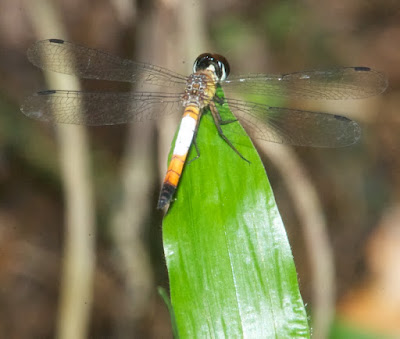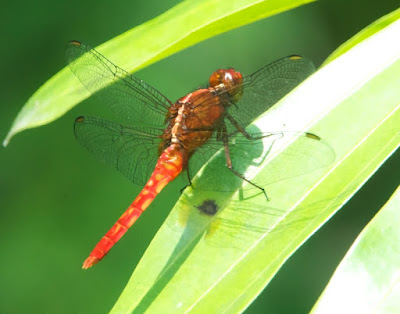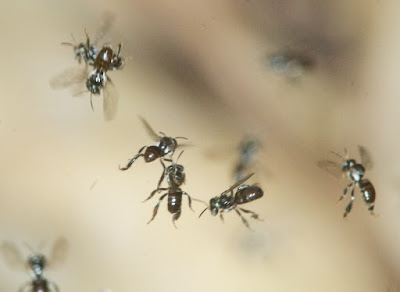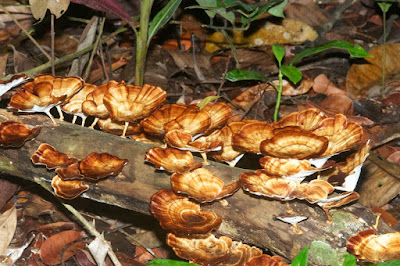Urban Kuching may not have the natural attractions of the parks and other natural areas not far from its borders, but (as readers of this blog should know by now) it has plenty to occupy an insect-watcher and, in particular, a dragonfly enthusiast. These photos, taken in October 2014 at, mostly, Sama Jaya and the MJC Road forest, should help prove my point.
I first met the lovely little Brachygonia oculata in the depths of Maludam National Park, and thought it quite the remote forest exotic until I found it at both MJC and Sama Jaya. It does prefer shade, though, and is easiest to find around the more heavily-wooded parts of both sites. All it needs is a bit of water; at Sama Jaya a rain puddle trapped between the roots of a forest tree may be enough.
Nannophya pygmaea, one of the world's smallest dragonflies if not the smallest, prefers sunnier spots. Even a flooded bit of lawn may support bright red males guarding their territories.
This dragonfly seems to prefer a trailside perch on an exposed twig about a metre off the ground, often in deep shade. Once perched, it will tolerate being repeatedly photographed, at close range, without stirring a bristle.
Out in the open, especially around the central pond, Sama Jaya supports quite a large array of common dragonflies. This is a female of the very common Neurothemis terminata.
There are the usual common Orthetrum species at both sites. This is Orthetrum chrysis.
I can hear my readers now: another photograph of the abundant Orthetrum sabina? Well, my apologies.
Dragonflies frequently carry a cargo of parasitic hitchhikers. This Orthetrum testaceum has picked up an infestation of mites (you can see them clinging to the bases of its wings).
These are all males (as far as I can tell) of Rhodothemis rufa, a common dragonfly at MJC. The upper photo shows a mature male, the lowest one a juvenile, and the two middle photos an individual that has begun, but has not, completed its transition to the bright red colour it will boast at maturity.
Brachydiplax chalybea is another very common dragonfly that my readers have undoubtedly tired of, but it does make a nice subject for a photograph or two.
Ceriagrion cerinorubellum is the most obvious damselfly at both Kuching sites, probably because it eats most of the others. This sequence shows a pair assuming the "wheel" position, in which the female picks up sperm packets that the male has previously transferred to his secondary sexual organs.
Though odonates are the insects that occupy most of my attention, they are of course not the only things for an insect-watcher to see. These little euglossine, or stingless, bees are typically insects of the rainforest, where they nest in tree hollows, but they have adapted to city (or at least suburban) life in Kuching.
The trails in Sama Jaya are frequently crossed by another forest insect, the Giant Forest Ant (Camponotus gigas) - probably the largest ant in the world, now sometimes placed in the genus Dinomyrmex (which means Terrible Ant). By day I usually find solitary workers, but by night they apparently band together into small groups of five to ten or so. The workers come in a variety of sizes; follow this excellent link to learn more, and to see photographs of the various castes.
I found this male Great Mormon (Papilio memnon), an impressive and remarkable butterfly indeed, in the forest at Sama Jaya. This is one of our larger swallowtails (and yes, it is a swallowtail despite the absence of tails on its wings). Like a number of other swallowtails, it is a mimic of other butterflies - but it is the female, not the male, that does the mimicry. Females Great Mormons are highly polymorphic, each colour form copying a different, distasteful swallowtail. The mimicry patterns of Great Mormons have intrigued biologists as far back as Alfred Russel Wallace in the 19th Century, and the genetics controlling them are still a subject of active study today.
Insect-watchers, of course, can be distracted by other things. Our eye can be caught by a Common Ground Skink (Mabuya multifasciata) before it scuttles away into the undergrowth...
...or distracted by the sheer beauty of the forest vegetation, especially when gingers like this one are in flower.
Fungi, too, can be delicately beautiful, as is this colony of Microporus xanthopus on a fallen limb at Sama Jaya.
In fact, a naturalist in Kuching doesn't even have to leave home to see something interesting. All that you have to do is leave a window open and turn the lights on. I have had individuals of both of the local, semi-nocturnal Zyxomma dragonflies fly into our apartment at Green Heights, and Ryan found this impressive insect in our lobby. It has a distinctive-ladder-like wing venation that helped me to identify it: Heliaeschna simplicia, a native of Sumatra, Borneo and a few islands in the Philippines, and a species of darner that is most active after dark. This female presumably flew in on the previous night.









































No comments:
Post a Comment